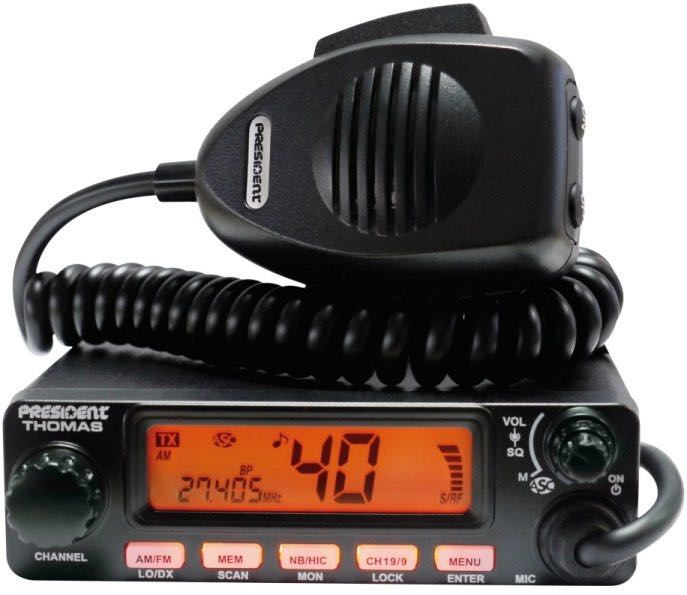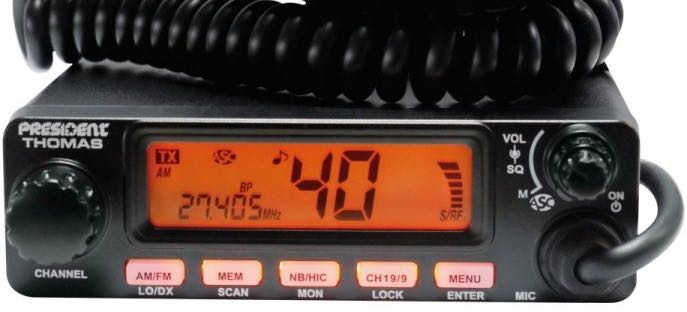Many thanks to SWLing Post contributor, Peter Laws, who shares the following guest post:
 Thomas is Famous!
Thomas is Famous!
by Peter Laws
A few weeks ago, a summary of the recent change to Title 47 of the Code of Federal Regulations, Part 95, Subpart D — better known as the rules for the CB Radio Service — was published here. That change, following a successful petition for reconsideration of a previous petition allowed FM as an additional mode in the CB Radio Service. The original petition was the one that caused the FCC to do away with the nearly-impossible-to-enforce “DX Rule” that prohibited communications of more than 250 km. For one, the ionosphere had a long history of ignoring the rule entirely, at least for part of the Sun’s eleven-year cycle.
In that article, the author speculated that it may not be too long before manufacturers brought radios that were capable of FM to market, since they already existed in other markets, namely countries that were members of CEPT.
That author has been watching the FCC OET site to see who will be the first out of the gate to get an FM CB approved. The Office of Engineering and Technology is the FCC’s line office that handles, among other things, Equipment Authorization. They also handle Experimental Licensing, i.e., “Part 5”, like the recent 630- and 2200-m band projects that resulted in new Amateur Radio allocations and the ongoing 8-m band experiments under WL2XUP (see that license’s details at https://apps.fcc.gov/oetcf/els/reports/CallsignSearch.cfm).
OET also provides a public database of equipment authorizations. If you know a radio device’s “FCC ID” (usually an alpha-numeric string found on the label of a device or in the device’s documentation), you can look up the details in the database. A manufacturer’s ID — the first 3 to 5 characters of a product’s ID — will show all the devices that have been authorized. Fortunately, you can limit the search by date as by frequency range. https://apps.fcc.gov/oetcf/eas/reports/GenericSearch.cfm Authorizations available online go back into the 1990s but the further back the results go, the less detailed they become.
So who won the race to bring the first FM-capable CB radio to the US market or at least to get a product authorized? Our benefactor, Mr Witherspoon, will be thrilled to hear that the first radio to gain FCC authorization is the President Thomas FCC!
As soon as President Electronics can get stock to distributors, the radio should be available. This writer has no information about when that may happen.
The President Thomas FCC is an older design (c.2013), meaning that whatever R&D costs President Electronics had for the bulk of the design will have been amortized years ago. As noted in the previous article, changes for conformity with the FCC Part 95 rules are expected to be minimal and likely have to do with locking out the “multi-norm” ability in the new model’s European counterpart. Following FCC rules, this is an AM radio that has FM as well. The new Part 95 regulations require AM in every radio with FM as a possible option.
Several websites have details on the existing President Thomas ASC (ASC is automatic squelch control). [See photos above.] It’s a multi-norm radio as is common in the European market and offers CEPT channels, UK channels, and Polish channels among others. CEPT channels are identical to the FCC allocations, UK channels are completely different though still between 27 and 28 MHz, and Polish channels are exactly like the FCC channels except that they are all 5 kHz lower (i.e., our Channel 19 is 27.185 while their Channel 19 is 27.180). Here is an example of a site with data on the European version: http://www.cbradio.nl/president/thomas.htm
FCC authorization was long ago turned over to contract labs. Here is the Equipment Authorization for the President Thomas FCC:
Peter Laws


A CB radio can have a 50 mile range. The CB radio base station range can be as high as 50 miles, which makes it one of the most powerful. More than the antenna, however, you must also factor in the operations in determining its distance.
A QRP transceiver with that name would be more appropriate I guess – it would be very small, mil-spec ruggedized and come with general coverage receiver, spectrum/waterfall and built-in key, mic and dog treat dispenser. 🙂
BTW, the FM legalization is way behind practical reality: In my CB days I used to work plenty of US stations in FM on a daily basis here in Germany during cycle 23 in 2000/2001. They heard us chatting on Ch41 (26.565 MHz) and called us, often in local nighttime even. Outstanding as that solar maximum was, they heard me transmitting on an indoor (!) double-bazooka style dipole with 12W off a President Lincoln (HR1510 for you guys).
I wonder what effect on sales and use will the FM characteristic of only demodulating the strongest signal will have? If there are 2 FM signals arrive at a receiver and one is stronger than the other, only the strongest will be heard, the weaker one will be inaudible. With SSB and AM you know that the weaker signal is there.
Australian Rules
HF Channel 1 26.965 MHz – channel 40 27.405 MHz AM 4 Watts power 6 kHz RF bandwidth or 12 Watts SSB RF bandwidth 3 kHz.
UHF Channel 1 476.425 MHz – UHF channel 23 476.975 MHz FM bandwidth 16 kHz, 5 Watts
UHF channel 1 476.425 MHz – UHF channel 80 477.4125 MHz FM bandwidth 10.1 kHz 5 Watts
Note: these frequencies are in the UHF TV band worldwide but Australia does not use channel 21 – 27 for TV.
Get an affordable 11m FM handheld on the market, and there might be some resultant consumer traction. To do so would incur addressing a few distinct issues. Some examples IMO:
1. Cost. Think Baofeng or similar engineering and quality to keep production costs done. A family, a group of hunters, etc. probably would want a near disposable handheld in the $35 or so price bracket, especially if buying a multpack of radios.
2. Power. Not so much output, as even a couple of watts on FM should suffice for near-range comms.. Think more about input. Li-ion is practically a requirement. Older CB handhelds tended to devour 8 AA batteries in short order if actually transmitting. Thankfully much of the power engineering can be derived from adorable FRS/GMRS and amateur handhelds.
Offer a 12v plugin option as well, even if it means buying as low-cost accessory adapter or whatever. Perhaps consider upping output power to a “full 4w” when a 12v source is available.
3. Antenna. Now we reach the truly difficult engineering part. A typical handheld-style short rubber duck helical antenna would be little more than a dummy load at 11m; not that some of them are much better even at 2m. o.0 Perhaps bundle one as a stock antenna, but allow it to detach with a BNC or SMA so better antennas can be use if desired. Loaded ~4′ telescopic and flexible antennas are available already for 11m handhelds.
2+3. Much like the 12v adapter option, offering branded “performance” antennas bakes in more accessory purchase opportunities.. Just like additional batteries, chargers, AA battery emergency power pack, speaker mics, etc. Even offer bundled kits with various accessories for a slight discount.
4. FRS/GMRS competition. Yeah, here is potentially the biggest selling roadblock. I suppose range might be a marketing aspect. Even GMRS tends to be maybe a mile or two with decent line of sight when using typical inexpensive blister-pack radios. FRS is not any better, and sometimes much work.
A single-user experience is not exactly scientific analysis, but my local comms record with a CB handheld back in the 1990s was about 18 to 20 miles. However, it had a rather long center-loaded telescopic antenna, which is not exactly what a typical consumer might want in a handheld transceiver.
Hmmm… now maybe I’ll send you my HyGain 2795dx which also has FM, Thomas, just a matter of recovering it from the box in my basement, wrapping it and shipping… that is, if you want it 🙂
(note: it has the pee-whip !)
I welcome the legalization of a new mode of operation (FM joins AM and SSB), but I doubt it will have any real popularity amongst CB’ers, although I suspect it could become popular as convenient mode for friends in, say, a caravan, all operating amongst themselves, where it would allow them to enjoy a sort of privacy.
Until FM becomes ubiquitous on the CB band, I don’t see it having a great impact because most contacts I hear on CB here in America are people searching out unknown others (calling CQ), rather than talking on a schedule (like a net), so until “everyone” adopts FM, it will be little more than a novelty.
Am I missing something? Is there some great benefit that allowing FM operation offers that will have a profound impact on CB in the US?
I suspect the main benefit might be for those who just want relatively short-range communications between family, members of specific groups, etc. and will therefore all purchase FM-capable radios. One of the advantages of FM is “capture effect,” which means that so long as the desired signal has a carrier stronger than other signals on the same channel, interference from those other signals is reduced, unlike on AM where you’ll hear much more of a cacophony of competing signals in the background. Despite gloomy predictions from the existing (illegal) AM-users when 27MHz FM was introduced to the U.K. in 1981, the system actually worked quite well for its intended short-range (helped by having unique channel allocations as well).
Thank you so much for the information, Peter! I’m so honored to have a CB radio branded in my name! Ha ha! Thanks for all of the background and links to the FCC docs! -Thomas